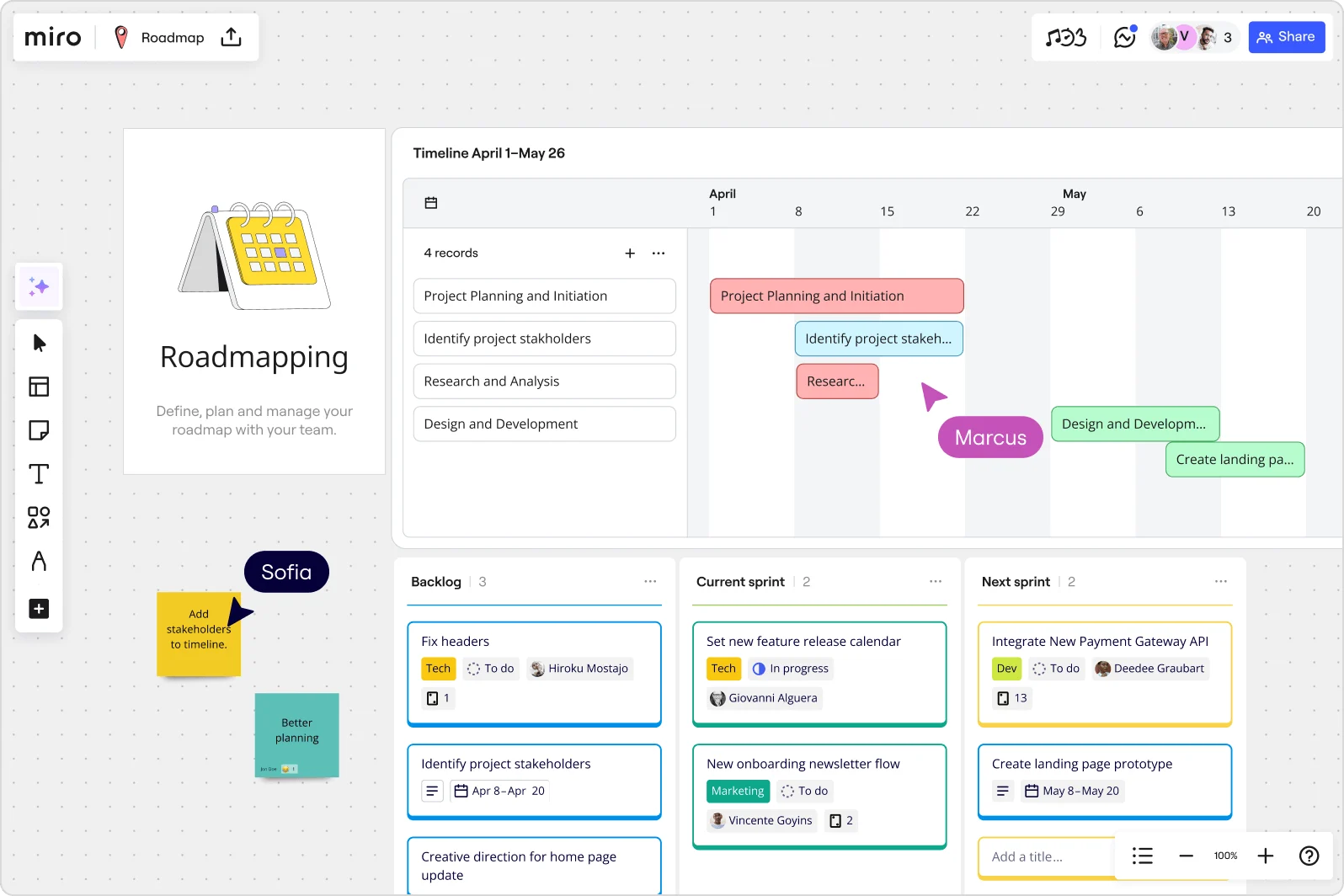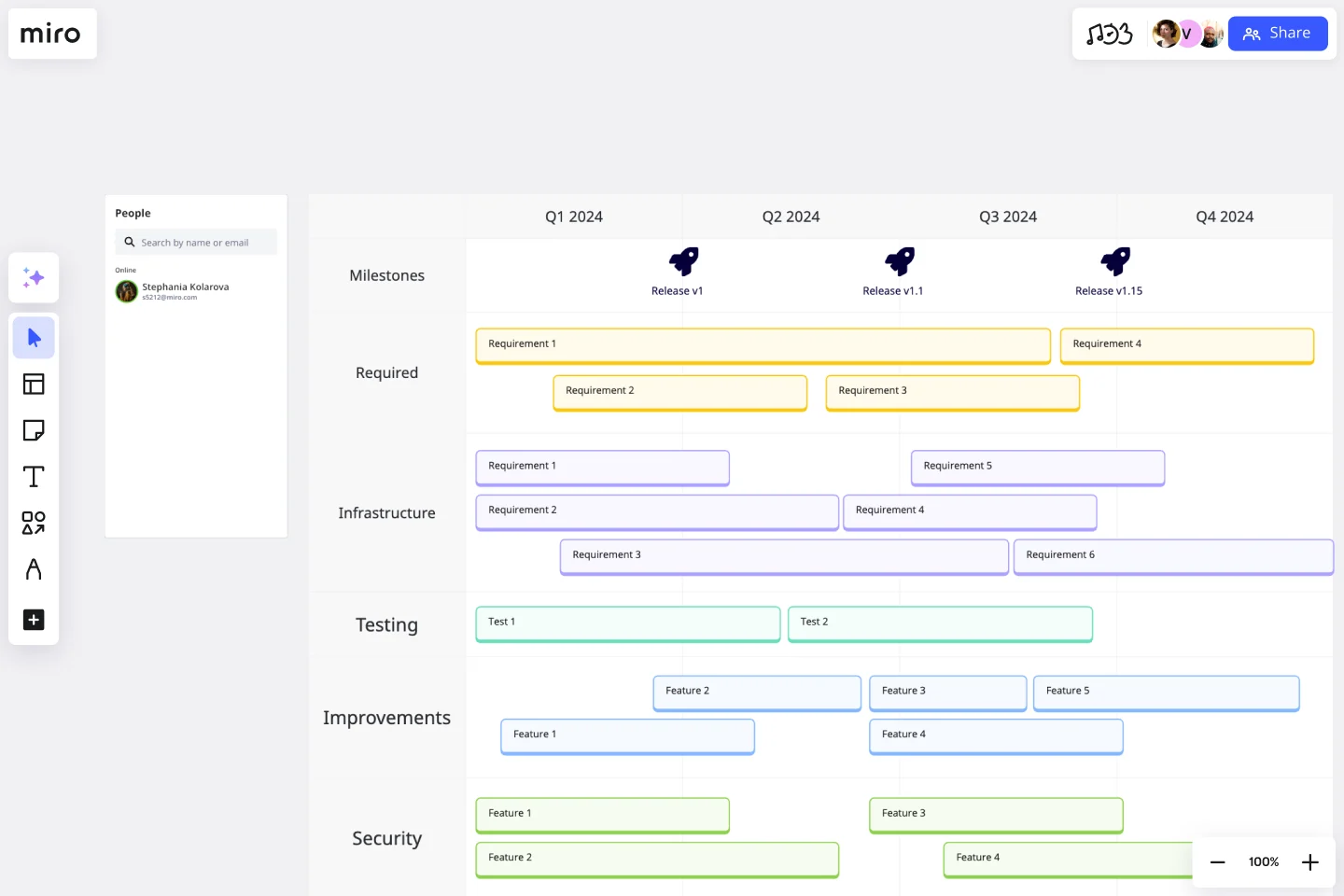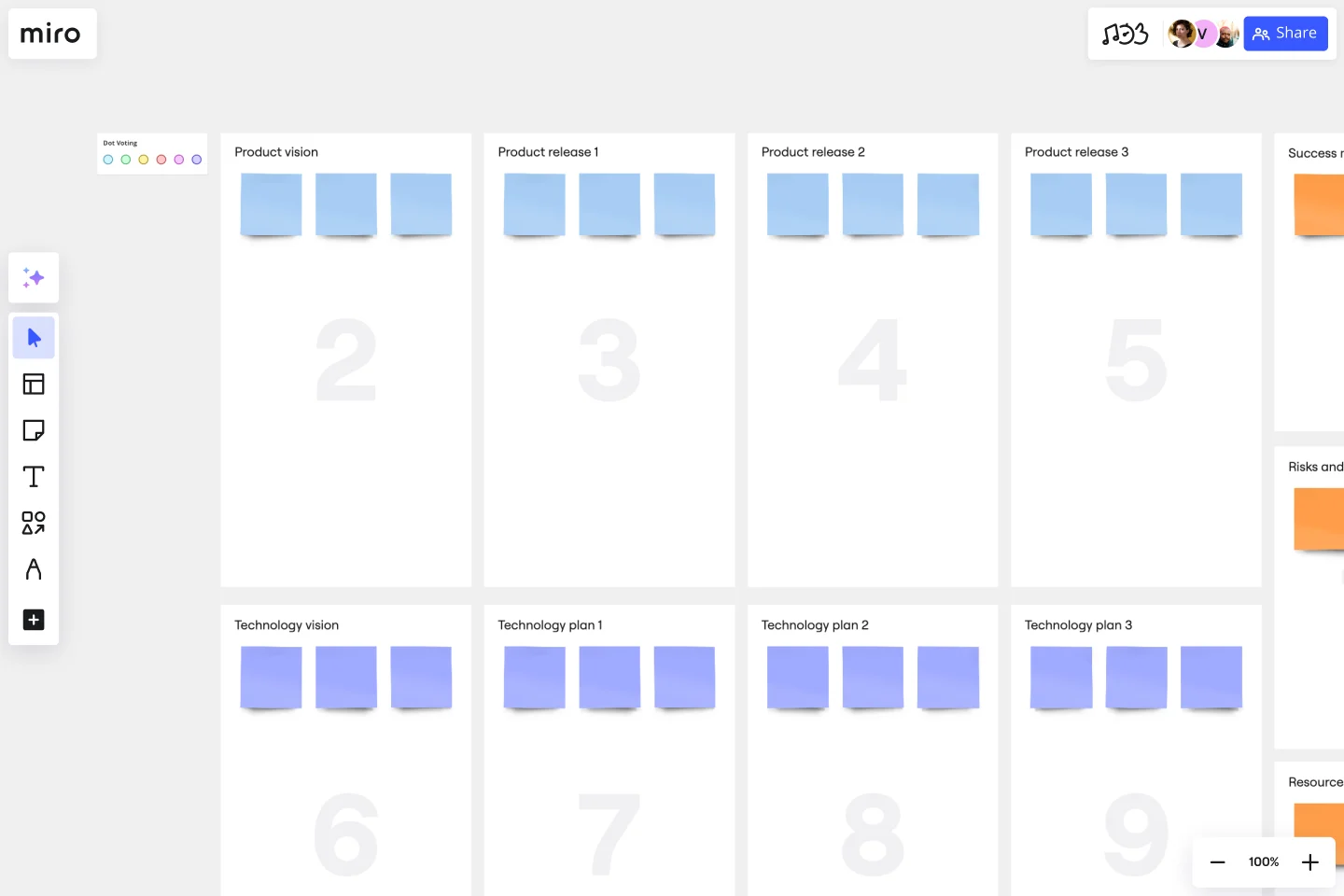
Technology roadmap examples to drive Agile innovation

Summary
In this guide, you will learn:
How Miro's technology roadmap templates help Agile teams visualize strategy, plan efficiently, and collaborate dynamically
Key steps to build a technology roadmap: defining themes, breaking down initiatives, setting flexible time horizons, mapping dependencies, tracking progress, and enabling team collaboration
The benefits of using Miro for roadmaps, including real-time and asynchronous collaboration, integration with tools like Jira, and easy adaptation to changing priorities
Features of effective product roadmap templates: strategic visibility, prioritization logic, cross-functional transparency, adaptability, and interactive collaboration tools
How to customize and use Miro's templates to add project goals, milestones, timelines, and track progress while sharing updates with stakeholders
Examples of specialized templates for product development, SAFe PO sync meetings, and roadmap planning that support alignment, communication, and agile execution
Try Miro now
Join thousands of teams using Miro to do their best work yet.
Creating a technology roadmap shouldn't feel like trying to predict the future. Instead, it should give your team clarity on where you're headed and why. Whether you're scaling a startup, leading product development, or managing a tech strategy at an enterprise level, a solid roadmap helps align stakeholders, prioritize initiatives, and keep innovation moving forward.
In this guide, we'll walk through technology roadmap templates and examples that Agile teams rely on, explore key templates to help you get started, and show you how to build your strategy with confidence using Miro's innovation workspace.
Technology roadmap explained
A technology roadmap is a strategic planning tool that outlines how technology initiatives align with business goals over time. It helps teams visualize dependencies, track progress, and ensure resources are allocated effectively.
For Agile teams, a technology roadmap isn't a rigid, one-size-fits-all plan. It's a dynamic framework that adapts as priorities shift. Instead of locking in fixed deadlines, Agile roadmaps focus on themes, goals, and iterative progress.
Key components of an Agile technology roadmap
Themes & objectives – These are the guiding pillars of your roadmap. Themes represent broad areas of focus, such as "Improving system scalability" or "Enhancing data security." Objectives within these themes break down what success looks like, ensuring that every initiative contributes to a clear business goal.
Initiatives & epics – Initiatives are large-scale projects that help achieve a theme's objectives. They often align with Agile epics, which represent a collection of related user stories. By structuring work into initiatives and epics, teams can manage complexity while keeping development efforts aligned with strategic goals.
Time horizons – Unlike rigid deadlines, time horizons categorize work into short-term, mid-term, and long-term plans. Short-term initiatives may focus on immediate improvements, mid-term on scalability and efficiency, and long-term on transformative innovations. This structure provides direction while allowing teams to adapt to evolving priorities.
Dependencies – Every technology roadmap should highlight interdependencies between teams, tools, or technologies. For example, launching a new API might depend on backend infrastructure updates. Mapping dependencies ensures that cross-functional teams collaborate effectively and avoid bottlenecks.
Milestones – While Agile roadmaps avoid fixed dates, milestones help track progress and celebrate achievements. These could include the launch of a beta version, completion of a security audit, or reaching a performance benchmark. Milestones provide checkpoints for evaluating progress without enforcing rigid deadlines.
With these components in place, your technology roadmap becomes a flexible yet structured tool that guides Agile development while remaining responsive to change.
Our technology roadmap template and how to use it

Our technology roadmap template is designed to help Agile teams visualize their strategy, plan efficiently, and collaborate asynchronously or in real time. Instead of wrestling with static documents, you can build an interactive, flexible roadmap that evolves with your team's needs.
How to use Miro's Technology Roadmap Template
Start with themes – Define overarching technology objectives (e.g., "Enhance AI capabilities" or "Improve DevOps automation"). These themes act as guiding principles, ensuring every initiative aligns with broader business goals.
Break down initiatives – Within each theme, identify major projects, epics, or feature clusters. This step helps create a clear structure for development efforts and prioritizes the most impactful work.
Set time horizons – Instead of fixed deadlines, organize initiatives into short-term, mid-term, and long-term phases. This approach gives teams flexibility while maintaining a strategic direction.
Map dependencies – Highlight relationships between initiatives, teams, or technologies. Mapping dependencies helps prevent bottlenecks and ensures cross-functional collaboration remains smooth.
Track progress – Use visual markers such as status indicators, labels, and milestone markers to monitor progress in real time. This transparency keeps stakeholders informed and enables quick adjustments when necessary.
Collaborate and refine – Since Miro is a fully collaborative innovation workspace, your entire team can contribute, leave feedback, and refine the roadmap dynamically. Whether working asynchronously or in real-time, teams stay aligned and engaged.
By following these steps, your technology roadmap becomes an evolving, strategic tool rather than a static document. Miro's intuitive visual interface makes it easy to adjust plans, adapt to new priorities, and ensure technology initiatives drive real business value.
Other templates to help you build your technology roadmap
Sometimes, a single roadmap isn't enough. Depending on your needs, you may want to explore different strategy canvas examples to shape your approach. Here are three additional templates that can help.
Technology Product Canvas Template

If you need to bridge the gap between business strategy and technical execution, the technology product canvas template is a great starting point. This tool helps teams define key product elements, such as customer needs, solution components, and technical constraints—all in one structured framework.
Use it to:
Align product development with technical feasibility.
Identify risks early in the process.
Create a shared understanding between business and engineering teams.
Product Development Roadmap Template

Building a product roadmap with a strong tech focus? The product development roadmap template helps Agile teams align engineering work with product goals. It provides a clear structure to organize releases, feature launches, and key development milestones.
Use it to:
Plan sprints and iterations effectively.
Keep stakeholders informed on upcoming releases.
Adjust priorities dynamically based on feedback.
Strategic Technology Roadmap Worksheets

For teams tackling high-level IT strategy, the strategic technology roadmap worksheets help structure long-term tech planning. This framework allows organizations to map out innovation, infrastructure improvements, and emerging technology adoption.
Use it to:
Define technology investment priorities.
Forecast trends and future capabilities.
Ensure alignment with business objectives.
Create your product strategy with confidence using Miro
A well-structured technology roadmap is more than a planning document—it's a shared vision that keeps your team aligned and adaptable. With Miro's innovation workspace, you can build and refine your roadmap visually, collaborate effortlessly, and ensure everyone stays on the same page.
Whether you're planning the next big feature, scaling your infrastructure, or mapping out a long-term tech vision, Miro's templates provide the clarity and flexibility you need to succeed. Try our technology roadmap templates today and start building a future-ready strategy with confidence.
Author: Miro Team
Last update: October 16, 2025